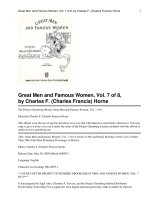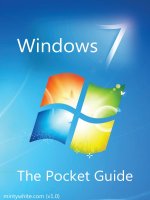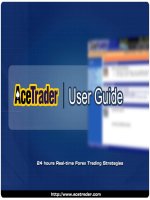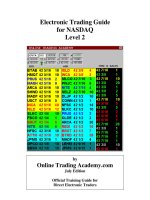Vol 7 futures trading guide
Bạn đang xem bản rút gọn của tài liệu. Xem và tải ngay bản đầy đủ của tài liệu tại đây (925.87 KB, 26 trang )
FUTURES TRADING GUIDE
Editor Matthew Carstens
WWW.INVESTING.COM
FOREX TRADING GUIDE
1
INDEX
The aim of this guide is to provide you with the prerequisite information that you will
need before venturing into futures trading. this guide is not intended to encourage
nor discourage you about futures trading. Any investment decision you make
should only be done after you have consulted your broker or financial advisor with
respect to your fnancial circumstances.
1. Brief History of Futures
Function of the exchange.............................................................................................. 4
2. What are Futures?
The Composition of a Future Contract........................................................................... 5
Futures Symbology........................................................................................................ 5
Product Symbol............................................................................................................. 5
Delivery Month............................................................................................................... 6
Year............................................................................................................................... 6
Available Futures Asset Classes..................................................................................... 7
3. Notable Futures Terms
Arb.............................................................................................................................. 13
Arbitrage..................................................................................................................... 13
Contract...................................................................................................................... 13
Contract size............................................................................................................... 13
Clearing....................................................................................................................... 13
Clearing House............................................................................................................ 13
Derivative..................................................................................................................... 14
Hedging...................................................................................................................... 14
Limit (Up or Down)....................................................................................................... 14
Margin Call.................................................................................................................. 14
Market Marker............................................................................................................. 14
Mark-to-Market........................................................................................................... 14
Pit................................................................................................................................ 14
Spot Price................................................................................................................... 15
Tick............................................................................................................................. 15
2
FUTURES TRADING GUIDE
WWW.INVESTING.COM
4. The Marketplace
Participants................................................................................................................. 16
Pit & Electronic Trading................................................................................................ 17
Exchanges.................................................................................................................. 17
Regulatory Bodies....................................................................................................... 18
5. Trading Futures
Margin and Leverage................................................................................................... 19
Rollover....................................................................................................................... 19
Physical & Cash Settlement......................................................................................... 20
6. 5 Trading Tips
7. Choosing a Broker
Commissions............................................................................................................... 24
Other fees................................................................................................................... 24
Broker reputation......................................................................................................... 25
Customer support....................................................................................................... 25
Intangibles................................................................................................................... 25
8. Trading Risks
Overtrading................................................................................................................. 26
Market Risk................................................................................................................. 26
Liquidity Risk............................................................................................................... 26
Excessive Leverage..................................................................................................... 26
Technology Risk/Internet Trading Risks........................................................................ 26
WWW.INVESTING.COM
FUTURES TRADING GUIDE
3
Brief History of Futures
Brief History of Futures
Playing an important role in the global fnancial system, futures exchanges can be
traced back to the “Tulip Mania” in the early sixteen hundreds when tulip traders
in the netherlands signed contracts before a notary to purchase tulips at the end
of the season.
What remained after what some consider to be the frst speculative bubble was the
foundation for modern day futures exchanges with attributes including centralized
trading, standardized contracts and regulation.
Then in the mid 1800’s as chicago found itself at the center of railroad and telegraph
lines and about the same time higher wheat production substantially increased
due to the invention of the McCormick reaper, wheat sellers found themselves at
the mercy of dealers after traveling with no storage facilities to speak of.
This then brought about the standardization of futures contracts where farmers
(sellers) and dealers (buyers) were able to exchange a specifc commodity for cash
at a said date in the future. Simply put, both the buyer and seller now knew exactly
what they could expect to receive in advance.
Function of the exchange
One of the key functions of any futures exchange is to provide for the clearing and daily
settlements of trades. The exchanges work with the FCM’s (your brokerage house) to
ensure that all trades are reconciled correctly.
Despite the changes that have occurred over time, the main purpose of the futures
market is still to provide an effective and effcient system for the management of price risk.
The purchase and selling of futures contracts provide a predetermined price for a future
purchase or sale thus allowing businesses and individuals to protect themselves against
adverse price changes.
Chicago has the largest futures exchange in the world, the CME (Chicago Mercantile
Exchange), which operates with both the open outcry (traders standing in a pit calling
out orders for execution) and electronic trading (through their Globex platform) methods.
As a sign of the times, now at least 70% of the CME’s futures contracts are executed over
Globex with over 1 million contracts traded or upwards of $50 billion in value.
4
FUTURES TRADING GUIDE
WWW.INVESTING.COM
What are Futures?
What are Futures?
Futures are standardized contracts that say how much of a specifed commodity
can be purchased or sold at a predetermined price and at a specifed time in the
future. These instruments are known as derivatives because the price is “derived”
from its underlying asset.
The Composition of a Future Contract
All the terms and conditions of a futures contract are predetermined by the exchange
prior to trading, but they commonly include the expiration date, the exchange, the tick
size and pricing unit, as well as the symbol.
Here is an example of the NYMEX Light Sweet Crude:
Symbol: CL
Example: march (H) 2012
Venue (exchange): CME Globex, CME ClearPort
Contract Unit: 1,000 barrels
Price Quotation (unit): U.S. Dollars and Cents per barrel
Minimum Fluctuation (tick size): $.01 per barrel
Futures Symbology
When looking for a trade, you’ll need to look up the asset by its symbol. Futures symbols
consist of 3 items.
• Product Symbol
• Delivery Month
• Year
Product Symbol
Since there are hundreds of products to choose from we’ll give an example of Natural
Gas here which would be, “NG”
WWW.INVESTING.COM
FUTURES TRADING GUIDE
5
What are Futures?
Delivery Month
Year
This is self-explanatory, so let’s use the year 2017 as an example. In this case you would
just denote the last 1 digit “7”.
NOTE: The symbol for a Natural Gas December 2017 contract would then be: NGZ7
6
FUTURES TRADING GUIDE
WWW.INVESTING.COM
What are Futures?
Available Futures Asset Classes
Futures can be categorized in several categories offering a wide range of assets to choose
from.
Agriculture
• Grains and Oilseeds
• Livestock
• Dairy
• Forest
• Commodity Indexes
• Sifts
Source: www.investing.com/commodities/softs»
WWW.INVESTING.COM
FUTURES TRADING GUIDE
7
What are Futures?
Source: www.investing.com/commodities/grains»
Source: www.investing.com/commodities/meats»
8
FUTURES TRADING GUIDE
WWW.INVESTING.COM
What are Futures?
Energy
• Crude Oil
• Ethanol
• Natural Gas
• Refned Products
• Coal
• Emissions
Source: www.investing.com/commodities/energies»
WWW.INVESTING.COM
FUTURES TRADING GUIDE
9
What are Futures?
Equity Index
• US Indexes
• International Indexes
• Sector Indexes
Source: www.investing.com/indices/indices-futures»
10
FUTURES TRADING GUIDE
WWW.INVESTING.COM
What are Futures?
FX or Currencies
• G10 Pairs
• Emerging Markets
• FX Volatility
• E-micros
Source: www.investing.com/currencies/fx-futures»
WWW.INVESTING.COM
FUTURES TRADING GUIDE
11
What are Futures?
Interest Rates
• Short Term Int Rates (STIR)
• US Treasury
• Swaps
• Interest Rate
• Sovereign Yield Spreads
Source: www.investing.com/rates-bonds/financial-futures»
12
FUTURES TRADING GUIDE
WWW.INVESTING.COM
Notable Futures Terms
Notable Futures Terms
Below is a list of notable terms and their basic defnitions used in the futures market.
Though it does not cover all of them (notably any Option terms), it should provide
you with a solid reference point on the major themes.
Arb
Hand gestures used to communicate orders in the pit.
Arbitrage
Simultaneous buying and selling of an asset to proft from a discrepancy in prices. This
may also include some aspects of hedging.
Contract
A standardized agreement between two parties detailing the quality, and quantity of an
underlying asset on a date in the future.
Contract size
Set by the exchange, this is the amount of a commodity controlled for 1 contract. For
instance 1 contract of gold represents 100 ounces of gold.
Clearing
The procedure through which the clearing house or association becomes the buyer to
each seller of a futures contract, and the seller to each buyer, and assumes responsibility
for protecting buyers and sellers from fnancial loss by assuring performance on each
contract.
Clearing House
Usually a division of an exchange where transactions executed on the foor are settled.
They also ensure delivery (if needed), and fnancing is taken care of between parties.
WWW.INVESTING.COM
FUTURES TRADING GUIDE
13
Notable Futures Terms
Derivative
A fnancial instrument where the price is directly dependent upon (i.e., “derived from”) the
value of another fnancial instrument(s). When trading derivatives, there is no transfer of
property.
Hedging
Taking offsetting positions usually in two different markets to minimize the risk of fnancial
loss.
Limit (Up or Down)
Set by the exchange, Limit Up or Limit Down is a maximum price increase/decrease from
the previous day’s settlement price within one trading session.
Margin Call
Usually due to adverse price movements against a trader, this is a request from a broker/
clearing frm to add more funds to cover their current position before their position is
subject to liquidation.
Market Marker
A dealer who has an obligation to buy when there is an excess of sell orders and to sell
when there is an excess of buy orders.
Mark-to-Market
A daily cash fow system used for a futures contract to maintain a minimum level of margin
equity that is calculated at the end of each trading day.
Pit
Also called a “ring”, this is an arena on the trading foor of some exchanges where trading
is conducted.
14
FUTURES TRADING GUIDE
WWW.INVESTING.COM
Notable Futures Terms
Spot Price
The price at which a physical commodity for immediate delivery is selling at a given time
and place.
Tick
The minimum change in price up or down.
WWW.INVESTING.COM
FUTURES TRADING GUIDE
15
The Marketplace
The Marketplace
The futures market space is made up of various trading participants, regulatory
bodies, exchanges and execution methods, all playing an essential role for a liquid
and functional market. Below is a list of each player and how they make up the
futures marketplace.
Participants
FCM (Futures Commission Merchant)
A broker or brokerage frm that executes orders on behalf of traders (clients) as well as
extends credit to them for margined transactions. They also hold client funds as well.
Hedgers
Hedgers are those who use the futures market to reduce the risk associated with price
fuctuation for a commodity which is going to be bought or sold at a future date. By fxing
the price for a commodity or product to be bought or sold in the future, hedgers can
avoid the risk of future price fuctuation especially when they are unsure how the market
will react.
Speculators
Persons engaged in speculating on price movements. Speculators do not participate in
the delivery process thus gain or lose money by offsetting futures and option instruments
before contract expiry. Speculators buy and sell in the Futures markets hoping to proft
from the very price changes which hedgers try to insure themselves against.
Floor Traders
An exchange member who executes trades on the exchange foor typically for his or her
own account. Also known as “locals”.
Floor Brokers
An employee of a member frm who executes trades on the exchange foor on behalf of
the frm’s clients.
16
FUTURES TRADING GUIDE
WWW.INVESTING.COM
The Marketplace
Pit & Electronic Trading
Pit Trading
Pit trading refers to trades done by floor brokers and floor traders on a trading pit (foor)
on an exchange. All trading and price discovery is done by humans in this environment
(called open outcry) where there is a trading pit for a number of different commodities.
Hand and verbal signals (known as Arb) are used to communicate orders in the pit.
Electronic Trading
Electronic Trading, referring to trading done through computerized trading markets,
continues to replace pit trading due to its expanded trading sessions, lower costs and
efficiency. Although more and more futures trades are conducted online, the trading pits
of the US Futures Exchanges are still a hive of activity.
NOTE: There are new products being created specifically for electronic trading like the
E-mini S&P 500 contract and the E-mini Nasdaq 100 contract.
Exchanges
There is a long list of futures exchanges listed globally, however here are many of the
major ones of note.
• CBOE – Chicago Board Options Exchange
• CME – Chicago Mercantile Exchange
• CBOT – Chicago Board of Trade
• ICE Futures – Part of Intercontinental Exchange
• KCBT – Kansas City Board of Trade
• MGEX – Minneapolis Grain Exchange
• Nadex
• NYMEX – New York Mercantile Exchange
• MX – Montreal Exchange
• Eurex
• LIFFE – London International Financial Futures and Options Exchange
• DBE – Dubai Mercantile Exchange
WWW.INVESTING.COM
FUTURES TRADING GUIDE
17
The Marketplace
Regulatory Bodies
Since futures are exchange traded, those exchanges are then regulated by a government
body.
Here is a list of major regulators and their residing country:
• CFTC – Commodity Futures Trading Commission, United States
• CVM – Securities Commission of Brazil
• FSA – Financial Services Authority, United Kingdom
• MAS – Monetary Authority of Singapore, Singapore
• FSA – Financial Services Agency, Japan
• SFC – Securities and Futures Commission, Hong Kong
• ASIC – Australian Securities and Investments Commission, Australia
Source: www.investing.com/brokers/regulation»
18
FUTURES TRADING GUIDE
WWW.INVESTING.COM
Trading Futures
Trading Futures
Futures trading is a leveraged product dealing with margin requirements, leverage
and expiring contracts that may or may not need to be rolled over to a forward
month. Below are details explaining these aspects of futures trading.
Margin and Leverage
As a leveraged product, futures would require margin (a performance bond) as collateral
to control a much larger position.
In the below example you can not only see how leverage is working, but the amount of
funds you would need to control a position of this size, whereas:
Initial margin: $3,300 per contract
1 contract of EUR / USD controls 125,000 units
Trader position: Long 10 contracts
The margin required on this position is calculated then as follows:
$3,300 x 10 = $33,000
With 1 contract controlling 125,000 Euros (contract size set by the exchange)
and you having 10 contracts, you would then control 1.25 million Euro’s with only
$33,000.
NOTE: Margin is set and adjusted by the exchange in accordance with volatility. typically
higher volatility will bring increased margin requirements for an asset.
Rollover
Since futures contracts expire, a trader needs to be prepared (if they are speculating and
do not want to take delivery of the asset) to rollover the contract to another front-month
(contract that has yet to expire).
Rollover is then the act of transferring expiring contracts into new non-expired ones.
Traders that wish to hold long term positions will have to rollover expiring contracts in
order to remain in their desired position.
WWW.INVESTING.COM
FUTURES TRADING GUIDE
19
Trading Futures
Example: Rollover – soybeans
Trader A has a long term bullish stance on soybeans. Let’s say he has
built a large long position in contracts that will expire in 3 months. When
the 3 months is up, he will have to make a rollover trade that will close out
the expiring contracts and open new contracts with maturity further out.
NOTE: It is up to the trader how far out he wishes to go with the new contracts.
This is done as follows:
Position: Long 50 June Soybean Futures at the time of expiry.
Rollover order would be:
Sell 50 June Soybeans to no longer have a June position then,
Buy 50 December Soybeans contracts (as they have a forward non-expired front month).
With this, the trader has successfully rolled his long position to a longer maturity.
Physical & Cash Settlement
As referenced before, futures contracts can be of two forms, either a contract for the
actual physical delivery of the asset in question or a call for cash settlement. In most
cases, for contracts calling for the delivery of assets, actual physical transfer is hardly ever
fulfilled. What usually happen is that an offsetting futures or options contract is procured
prior to the fulfillment date as a means of proft taking. A cash settled instrument will then
be closed at expiration closing the other side of the opening trade (buy or sell) using the
settlement price at expiration.
Example: Physical settlement – gold Futures
In the most basic sense, a seller would deliver one contract of gold (100
oz) conforming to the standards set by the exchange and agreed on by
the other party to a location also predetermined.
NOTE: Less than 5% of futures contracts in the US are delivered.
20
FUTURES TRADING GUIDE
WWW.INVESTING.COM









